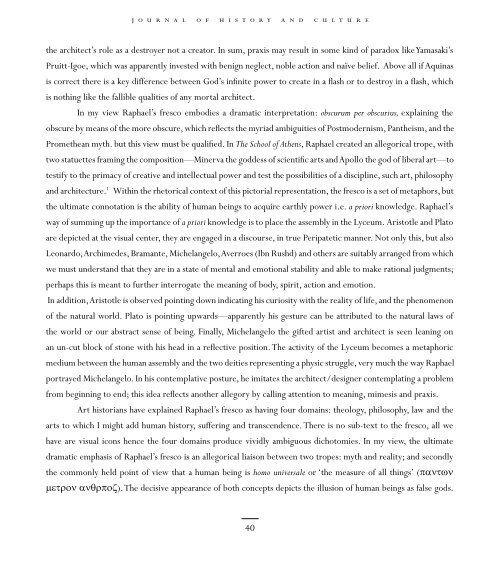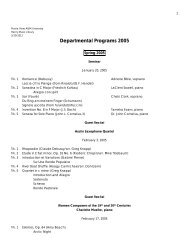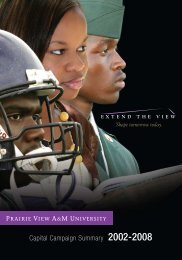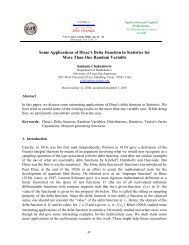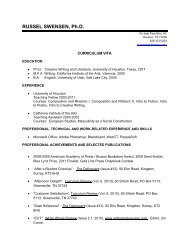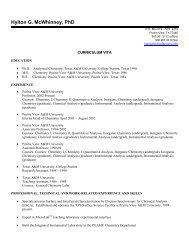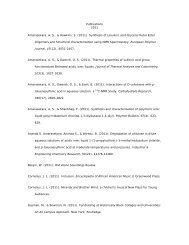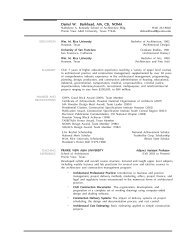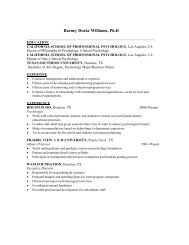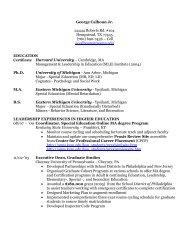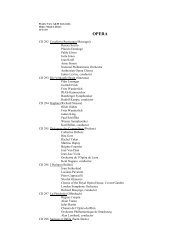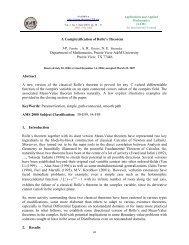Journal of History and Culture Journal of History and Culture
Journal of History and Culture Journal of History and Culture
Journal of History and Culture Journal of History and Culture
You also want an ePaper? Increase the reach of your titles
YUMPU automatically turns print PDFs into web optimized ePapers that Google loves.
j o u r n a l o f h i s t o r y a n d c u l t u r e<br />
the architect’s role as a destroyer not a creator. In sum, praxis may result in some kind <strong>of</strong> paradox like Yamasaki’s<br />
Pruitt-Igoe, which was apparently invested with benign neglect, noble action <strong>and</strong> naïve belief. Above all if Aquinas<br />
is correct there is a key difference between God’s infinite power to create in a flash or to destroy in a flash, which<br />
is nothing like the fallible qualities <strong>of</strong> any mortal architect.<br />
In my view Raphael’s fresco embodies a dramatic interpretation: obscurum per obscurius, explaining the<br />
obscure by means <strong>of</strong> the more obscure, which reflects the myriad ambiguities <strong>of</strong> Postmodernism, Pantheism, <strong>and</strong> the<br />
Promethean myth. but this view must be qualified. In The School <strong>of</strong> Athens, Raphael created an allegorical trope, with<br />
two statuettes framing the composition—Minerva the goddess <strong>of</strong> scientific arts <strong>and</strong> Apollo the god <strong>of</strong> liberal art—to<br />
testify to the primacy <strong>of</strong> creative <strong>and</strong> intellectual power <strong>and</strong> test the possibilities <strong>of</strong> a discipline, such art, philosophy<br />
<strong>and</strong> architecture. 1 Within the rhetorical context <strong>of</strong> this pictorial representation, the fresco is a set <strong>of</strong> metaphors, but<br />
the ultimate connotation is the ability <strong>of</strong> human beings to acquire earthly power i.e. a priori knowledge. Raphael’s<br />
way <strong>of</strong> summing up the importance <strong>of</strong> a priori knowledge is to place the assembly in the Lyceum. Aristotle <strong>and</strong> Plato<br />
are depicted at the visual center, they are engaged in a discourse, in true Peripatetic manner. Not only this, but also<br />
Leonardo, Archimedes, Bramante, Michelangelo, Averroes (Ibn Rushd) <strong>and</strong> others are suitably arranged from which<br />
we must underst<strong>and</strong> that they are in a state <strong>of</strong> mental <strong>and</strong> emotional stability <strong>and</strong> able to make rational judgments;<br />
perhaps this is meant to further interrogate the meaning <strong>of</strong> body, spirit, action <strong>and</strong> emotion.<br />
In addition, Aristotle is observed pointing down indicating his curiosity with the reality <strong>of</strong> life, <strong>and</strong> the phenomenon<br />
<strong>of</strong> the natural world. Plato is pointing upwards—apparently his gesture can be attributed to the natural laws <strong>of</strong><br />
the world or our abstract sense <strong>of</strong> being. Finally, Michelangelo the gifted artist <strong>and</strong> architect is seen leaning on<br />
an un-cut block <strong>of</strong> stone with his head in a reflective position. The activity <strong>of</strong> the Lyceum becomes a metaphoric<br />
medium between the human assembly <strong>and</strong> the two deities representing a physic struggle, very much the way Raphael<br />
portrayed Michelangelo. In his contemplative posture, he imitates the architect/designer contemplating a problem<br />
from beginning to end; this idea reflects another allegory by calling attention to meaning, mimesis <strong>and</strong> praxis.<br />
Art historians have explained Raphael’s fresco as having four domains: theology, philosophy, law <strong>and</strong> the<br />
arts to which I might add human history, suffering <strong>and</strong> transcendence. There is no sub-text to the fresco, all we<br />
have are visual icons hence the four domains produce vividly ambiguous dichotomies. In my view, the ultimate<br />
dramatic emphasis <strong>of</strong> Raphael’s fresco is an allegorical liaison between two tropes: myth <strong>and</strong> reality; <strong>and</strong> secondly<br />
the commonly held point <strong>of</strong> view that a human being is homo universale or ‘the measure <strong>of</strong> all things’ (!"#$%#&<br />
'($)*#&"#+)!*,). The decisive appearance <strong>of</strong> both concepts depicts the illusion <strong>of</strong> human beings as false gods.<br />
40


